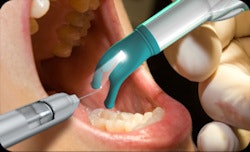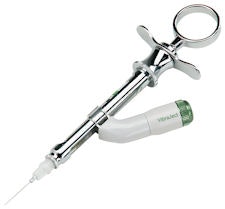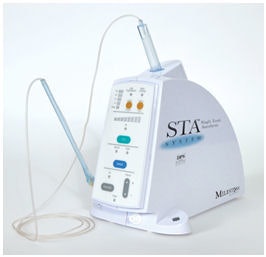
One of the most stressful events of any dental visit is an injection. Anxiety levels rise for everyone in the room, with the patient anticipating the potential pain and the dentist trying to figure out ways to avoid causing it.
"In dental school, we are all taught to inject slowly. We are all capable of injecting slowly, but in the real world, we seldom take the time to do so. It's just not human nature, as both the patient and the doctor want the injection to be over with as quickly as possible," wrote Martin Jablow, D.M.D., in a recent Ask Marty column.
As a result, a number of injection systems have come onto the market that are designed to make the process easier. Most of these products take advantage of the gate control theory of pain management, which suggests that pain can be reduced by simultaneous activation of nerve fibers through the use of vibration.
A 2009 study of the effects of vibration on pain experienced during local anesthetic injections, for example, compared pain from injections with and without a simultaneous vibration stimulus using both infiltration and block anesthetic injection techniques and concluded that vibration can be used to decrease pain during dental local anesthetic administration (Australian Dental Journal, June 2009, Vol. 54:2, pp. 94-100). In addition, compared to injections without vibration stimulus, injections with vibration resulted in fewer pain descriptors used by patients.
However, an earlier study found "no statistically significant decrease in pain scores at needle insertion or anesthetic injection" following use of a vibrating anesthesia attachment (Anesthesia Progress, Summer 2005, Vol. 52:2, pp. 62-64).
Below is an overview of five injection systems developed for dental applications: Accupal, DentalVibe (just introduced last month), VibraJect, STA, and Med-Jet. Three of them -- the Accupal, DentalVibe, and VibraJect -- are all similar in their methodology, according to Dr. Jablow.
"The vibration is basically a distraction," he said. "And because of the gate control theory, they work."
The STA system is unique in that it does a single injection in a periodontal ligament, he added. He is not familiar with the Med-Jet, which is not yet commercially available.
Accupal
The Accupal cordless palatal injection system uses vibration to precondition oral tissue. Accupal vibrates the injection site 360° proximal to the needle penetration, which shuts the "pain gate," according to the company. After placing the device at the injection site, the unit lights up the area and begins to vibrate. The dentist then places the needle through a hole in the head of the device to deliver the injection.
 |
| Accupal's Numblebee injection system is designed for pediatric patients. |
Accupal President Michael Zweifler, D.D.S., told DrBicuspid.com that he invented the system because he was "sick and tired of apologizing to ... patients for inflicting pain and fear" during injections.
"When used properly, patients have no discernable perception of the needle penetrating tissue," he said.
Accupal recently expanded its product line with the I/A model, designed for mandibular shots, that results in more first-time "hits" for the inferior alveolar nerve block, according to the company. Accupal also offers the black and gold Numblebee, which is geared for pediatric patients and is designed to distract children during injections.
Accupal devices have been sold in 13 countries and cost $499.
DentalVibe
DentalVibe, a cordless injection system introduced at the recent Chicago Dental Society Midwinter Meeting, also uses vibration diversion based on the pain gate theory.
 |
| The DentalVibe cordless injection system. |
The device's forked tip stimulates A-beta nerve fibers that travel much faster than C-nerve fibers, which carry pain sensations, explained Dr. Steven G. Goldberg, D.D.S., the company president and inventor. As a result, the brain registers the vibrations instead of the pain. It also lights the injection area and retracts the lips.
Dr. Goldberg commends dentists "who are concerned enough about the comfort of their patients to seek out anything that will help alleviate the pain and fear of the dreaded dental injection."
"After all, we can all relate to this, as we are all dental patients," he said.
DentalVibe also makes attachments that resemble finger puppets for use on pediatric patients to distract children.
The DentalVibe sells for $795.
 |
| The VibraJect by ITL Dental. |
VibraJect
VibraJect from ITL Dental also uses vibration and the pain gate theory to ease injection discomfort. This battery-operated device attaches to the barrel of the syringe, causing the needle itself to vibrate.
VibraJect is more effective at blocking pain because it affects the nervous system, according to ITL President Courtney Emery. "The key thing is we're actually blocking the pain of dental injections so the patient has a more comfortable dental experience," he explained.
More than 10,000 of the devices have been sold worldwide since it was introduced in 2002, Emery said.
Prices for the VibraJect range from $289 to $359 for rechargeable models.
STA
 |
| Milestone Scientific's STA system. |
The STA (single tooth anesthesia) system from Milestone Scientific also uses a vibrational method to ease pain. Additionally, it tells dentists if they have positioned the needle properly (visual and auditory signals) and controls the anesthesia flow to provide low-pressure injections.
The unit is designed to do intraligamentary periodontal ligament (PDL) injections, replacing the need for inferior alveolar blocks for single-tooth anesthesia.
"Because the unit is controlling the flow of anesthesia, there's no pain," Renee Cultrara, a dental hygienist and clinical product specialist for Milestone, told DrBicuspid.com. "There's no tissue piercing because the needle goes between the gum tissue and the tooth, directly into the sulcus."
The STA sells for about $1,995.
Med-Jet
Medical International Technology (MIT) is waiting for FDA clearance before launching a version of its Med-Jet needleless injector for the dental market. Current versions use pressure to create a thin jet of medication with enough force to directly enter the patient's soft tissue without the use of a needle.
MIT plans to launch its dental product, the Med-Jet MIT-H-VI, in North America first before introducing it in other countries, the company said.
Copyright © 2010 DrBicuspid.com



















